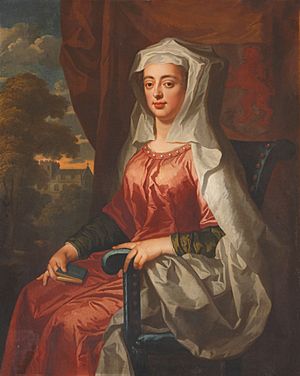Dervorguilla of Galloway facts for kids
Quick facts for kids Dervorguilla of Galloway |
|
|---|---|

Dervorguilla of Galloway, Lady of Balliol by Wilhelm Sonmans
|
|
| Born | c. 1210 |
| Died | 28 January 1290 |
| Spouse | John I de Balliol |
| Issue | Hugh de Balliol Alan de Balliol Alexander de Balliol John Balliol Cecily de Balliol Ada de Balliol William de Balliol Margaret de Balliol Eleanor de Balliol Maud de Balliol |
| Father | Alan of Galloway |
| Mother | Margaret of Huntingdon |
Dervorguilla of Galloway (born around 1210 – died January 28, 1290) was an important lady in 13th-century Scotland. She was married to John, 5th Baron de Balliol. She was also the mother of John I, who later became a King of Scotland. Her name, Dervorguilla, comes from the old Gaelic name Dearbhfhorghaill.
Dervorguilla's Family Tree
Dervorguilla was one of three daughters of Alan, Lord of Galloway, a powerful Gaelic prince. Her mother was Margaret of Huntingdon. Margaret was the daughter of David, Earl of Huntingdon. David was the younger brother of two Scottish Kings, Malcolm IV and William the Lion. This means Dervorguilla was related to the Kings of Scotland through her mother, including King David I.
In 1234, Dervorguilla's father passed away. He did not have any sons who could legally inherit his lands. According to both Anglo-Norman and ancient Gaelic customs, Dervorguilla became one of his heiresses. Her two older sisters, Helen and Christina, were also heiresses. Because of this, Dervorguilla passed on lands in Galloway to her children. Her son, John of Scotland, later became a King of Scots. People sometimes called him Toom Tabard, which means "empty coat" or "puppet king" in Scots.
Her Life and Legacy
Dervorguilla married into the Balliol family, who lived at Barnard Castle in County Durham, England. She was about 13 years old when she married. This was a common age for marriage at that time.
In 1263, Dervorguilla's husband, Sir John, had to make up for a land disagreement. Part of his penance was to help start a college for poor students at the University of Oxford. Sir John did not have as much money as his wife. So, after he died, Dervorguilla took over this important project. She officially set up the college in 1282. She also gave it money to keep running and wrote its first rules. This college is still known as Balliol College today. At the college, a history club for students is named the Dervorguilla Society. There is also an annual seminar series for women in academics called the Dervorguilla Seminar Series.

Dervorguilla also founded a Cistercian Abbey in April 1273. It was built about 7 miles south of Dumfries and Galloway in Scotland. This abbey is still standing today as a beautiful ruin made of red sandstone. It is believed that she also helped create the first library in Dundee.
When Sir John, her husband, died in 1269, Dervorguilla had his heart preserved. She kept it in a special box made of ivory and silver. This box traveled with her for the rest of her life.
In her later years, the main royal family of Scotland was in danger of not having a male heir. Dervorguilla passed away just before the young queen, Margaret, the Maid of Norway. If Dervorguilla had lived longer than Margaret, she might have been one of the people claiming the Scottish throne. Dervorguilla was buried next to her husband at New Abbey. This abbey was later named 'Sweetheart Abbey', a name it still has today. Sadly, over time, both of their graves were lost. A copy of her grave can be seen in the abbey today.
Her Children and Successors
Dervorguilla and John de Balliol had several children:
- Sir Hugh de Balliol, who died without children.
- Alan de Balliol, who also died without children.
- Sir Alexander de Balliol, who died without children.
- King John of Scotland, who became King in 1292.
- Cecily de Balliol, who married John de Burgh.
- Ada de Balliol, who married William de Lindsay.
- William de Balliol, who had a son named John LeScott.
- Margaret, who never married.
- Eleanor de Balliol, who married John II Comyn, Lord of Badenoch.
- Maud, who married Sir Bryan FitzAlan, Lord FitzAlan.
Because her three older sons passed away without children, Dervorguilla's fourth and youngest surviving son, John of Scotland, claimed the Scottish crown in 1290. This happened when Queen Margaret died. John won against his rival, Robert Bruce, 5th Lord of Annandale, in 1292. He then ruled as King of Scotland for four years, from 1292 to 1296.
See also


